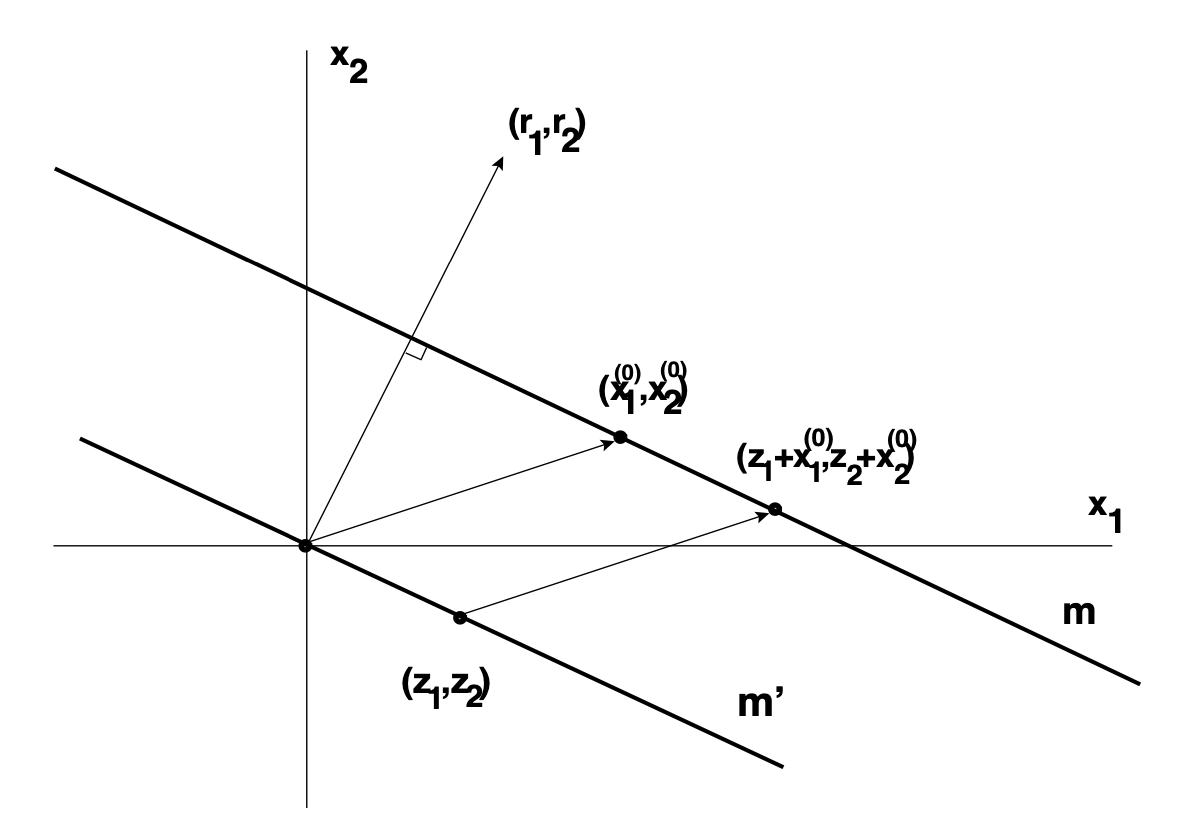3.4: The General Solution of ax+by = c
- Page ID
- 60311
Definition 3.8
Let \(r_{1}\) and \(r_{2}\) be given. The equation \(r_{1}x + r_{2}y = 0\) is called homogeneous. The equation \(r_{1}x + r_{2}y = c\) when \(c \ne 0\) is called inhomogeneous. An arbitrary solution of the inhomogeneous equation is called a particular solution. By general solution, we mean the set of all possible solutions of the full (inhomogeneous) equation.
It is useful to have some geometric intuition relevant to the equation \(r_{1}x + r_{2}y = c\). In \(\mathbb{R}^2\), we set \(\vec{r} = (r_{1}, r_{2}), \vec{x} = (x, y)\), etcetera. The standard inner product is written as \((\cdot, \cdot)\). The set of points in \(\mathbb{R}^2\) satisfying the above inhomogeneous equation thus lie on the line \(m \subset \mathbb{R}^2\) given by \((\vec{r}, \vec{x}) = c\).
This line is orthogonal to the vector \(\vec{r}\) and its distance to the origin (measured along the vector \(\vec{r}\)) equals \(\frac{|c|}{\sqrt{(\vec{r}, \vec{r})}}\). The situation is illustrated in Figure 7.
It is a standard result from linear algebra that the problem of finding all solutions of a inhomogeneous equation comes down to to finding one solution of the inhomogeneous equation, and finding the general solution of the homogeneous equation.
Lemma 3.9
Let \((x^{(0)}, y^{(0)})\) be a particular solution of \(r_{1}x+r_{2}y = c\). The general solution of the inhomogeneous equation is given by \((x^{(0)}+z_{1}, y^{(0)}+z_{2})\) where \((z_{1}, z_{2})\) is the general solution of the homogeneous equation \(r_{1}x+ r_{2}y = 0\).

Figure 7. The general solution of the inhomogeneous equation \((\vec{r}, \vec{x})= c\) in \(\mathbb{R}^2\).
- Proof
-
Let \((x^{(0)}, y^{(0)})\) be that particular solution. Let \(m\) be the line given by \((\vec{r}, \vec{x})= c\). Translate \(m\) over the vector \((-x^{(0)}, -y^{(0)})\) to get the line \(m'\). Then an integer point on the line \(m'\) is a solution \((z_{1}, z_{2})\) of the homogeneous equation if and only if \((x^{(0)}+z_{1}, y^{(0)}+z_{2})\) on \(m\) is also an integer point (see Figure 7).
Be ́zout’s Lemma says that \(r_{1}x + r_{2}y = c\) has a solution if and only if \(\gcd (r_{1}, r_{2}) | c\). Theorem 3.4 gives a particular solution of that equation (via the Euclidean algorithm). Putting those results and Proposition 3.5 together, gives our final result.
Corollary 3.10
Given \(r_{1}, r_{2}\), and \(c\), the general solution of the equation \(r_{1}x+r_{2}y = c\), where \(\gcd(r_{1}, r_{2}) | c\), is the sum of the particular solution of Theorem 3.4 and the general solution of \(r_{1} x+r_{2} y = 0\) of Proposition 3.5.


